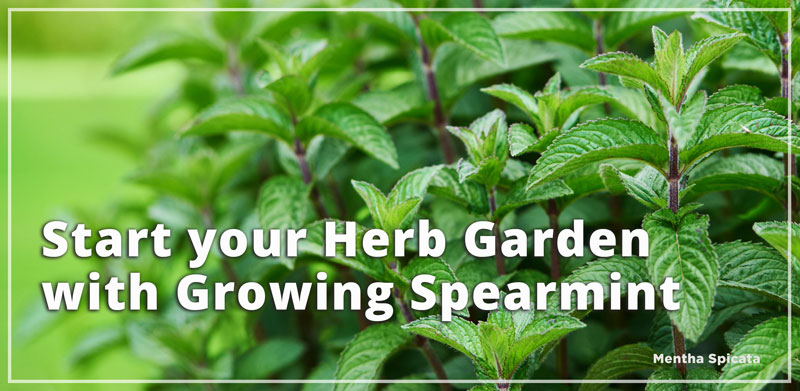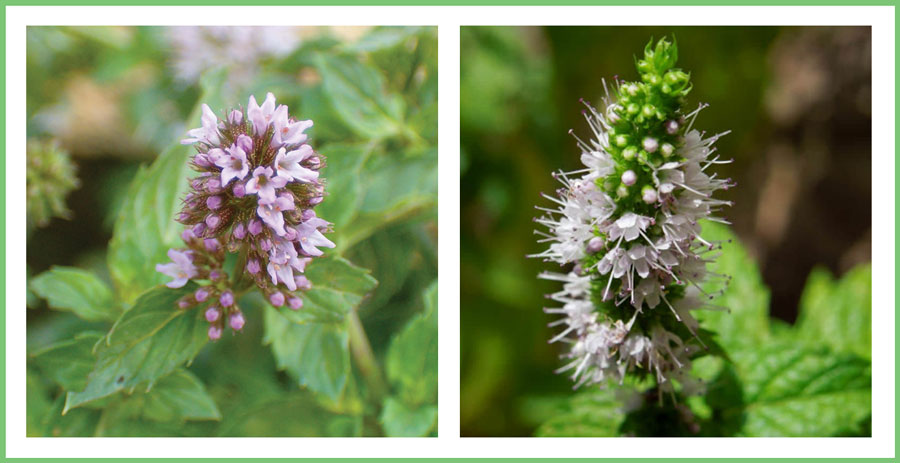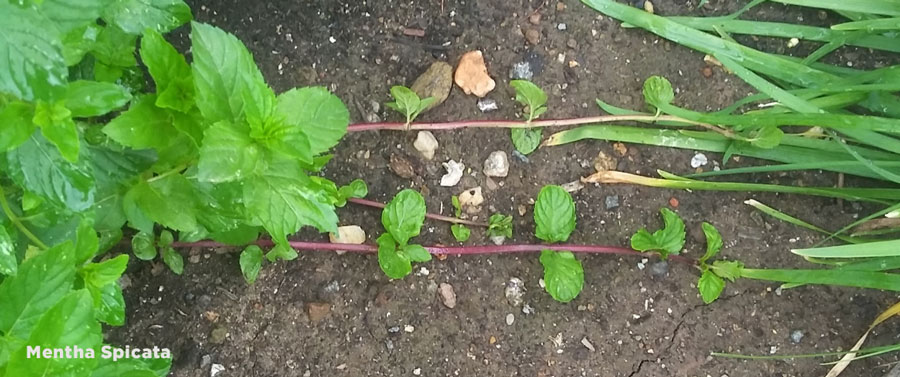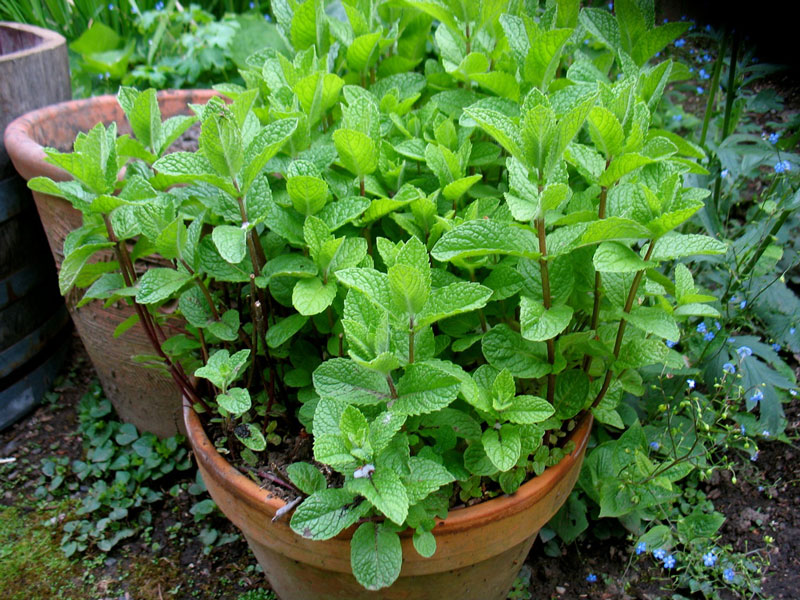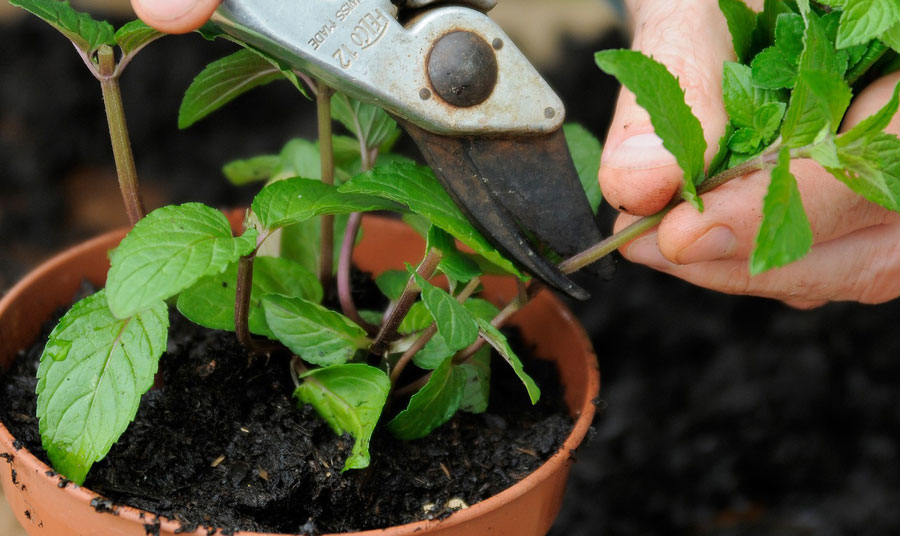START YOUR HERB GARDEN WITH GROWING SPEARMINT
Spearmint (Mentha Spicata) is considered to be one of the most popular herb plants around the world. This herb is loved especially because of its strong pleasant scent and tasty flavour in tea. Spearmint is a beautiful green plant, it keeps mosquitos away and you can also add the leaves to many recipes and drinks (Tea and Mojito’s are my favourites).
Spearmint is easy to grow, it grows quickly with little effort and it is hard to kill … that is why I believe spearmint is probably the best option for getting started.
This herb requires a little bit of maintenance, a few specific conditions to take care of and you will see sprouting mint leaves in no time. It is absolutely the best choice for a first plant for every beginning herb gardener, whether it is indoors or outdoors.
Spearmint Plant Data
Name :
Spearmint (Botanical name : Mentha Spicata)
Description :
Spearmint commonly grows nowadays on the five continents around the world, and generally prefers a place in semi-shade or full sun, in a moist but well-drained, alkaline soil with many nutrients. This hardy perennial herb grows to a minimum of thirty centimeters and a maximum of one meter high.
This plant is a strong grower whose leaves can be harvested almost year round. The leaves are smooth, bright green and elongated with a pointed end. The name spearmint refers to the spear-shaped leaves. The flowers can have a white or pink to lilac colour and grow in clusters at the end of the stem.
Spearmint is often found in health-food products, toothpastes, chewing gum and cosmetics. It is often used in medicine for its claimed therapeutic properties.
Don’t let mint take over your garden
Let me start with a warning : Don’t let mint take over your garden! Mint is a fast growing herb that spreads very fast with horizontal roots, called ‘runners’. These runners, underneath the ground or on the surface can be pretty invasive. On the picture below you can see an example of these runners on the surface.
The advantage is that this herb plant can be propagated through its roots. But to keep the plant in check (to contain the roots) in an herb garden, it is better to put this plant in large containers or pots or it will take over the spots of the other herbs. That is why I prefer to grow mint in pots or containers, outdoors as well as indoors.
Find the best spot in the garden
Mint is a very versatile plant. It will grow in full sunn and partial shade. If you live in a dry and warm climate, you may want to consider to grow them in partly shaded positions, just to protect it from the extreme heat. Mint doesn’t like that a lot.
If you live in a really cold climate, I would suggest you put the plant in a position where it gets full sun.
Does mint grow all of the time?
Mint is a hardy perennial and the length of the outdoor growing season depends of course on the climate and weather conditions (read temperature) of the area where you are living. The hardiness of mint will depend also on the variety you are growing.
Spearmint will grow in a wide range of climates. It is very cold hardy, able to withstand the cool winter temperatures (in USDA hardiness zone 3). It can also handle the heat very well, it can survive in summertime. The hardiness zones give an indication of the average annual minimum winter temperature in that zone. This means that spearmint in the ground can even survive winter conditions as low as -40 degrees Fahrenheit or -40 degrees Celsius.
The ideal growing temperatures for mints are warm sunny days (24°C) and cool nights (14°C). In all of the different climates Spearmint requires plenty of sun but in the hotter climates, mint generally grows better in the more shaded areas of the garden.
So outdoors, the start and the end of the growing season depends on the tempearture. Mint thrives in both cool and warm climates. In warm climates spearmint, like other mints, grows year-round. It doesn’t need a dormant period at all. In colder climates, the roots generally survive the winter period quite well. The top leaves will die off during winter, though when the temperature warms up spearmint leaves they will grow back and are often one of the first to arrive each spring.
It is wise to harvest heavily at the end of the growing season and to prune it back to about an inch above the ground.
Indoors we are controlling the temperature ourselves. Although spearmint (like any other herb) won’t grow as fast and strongly as outdoors, you can enjoy fresh mintleaves year-round, even in winters!
Pruning and harvesting
Pruning – cutting or pinching – off the tips of the plant will make it grow more branches and leaves. This way the plant will become fuller, bushier and more succulent rather than woody, dry and tough. Make sure to remove the ugly spindly and dried stems regularly to keep the plant looking healthy and in shape.
A a rule of thumb I want to make sure that my new mint plants had sufficient time to firmly root themselves in the soil before I start serious harvesting. This might take a couple of weeks depending on the climate and time of year. When the mint plant is ready for harvesting, I see to it to cut off no more than two third of the stem with sharp shears, just above a node. New leaves will sprout from these nodes.
Once a mint plant is growing at a regular tempo, you will of course prune the plant, whenever you need leaves for drinks or food seasoning, but if you don’t need it for some reason for a couple of weeks, it is wise to give the plant a “haircut” to avoid it gets dry and ugly.
Whenever the plant goes dormant outdoors, you should also give it a hard prune back, almost to the roots and get rid off all the older woody parts. This way you will get a beautiful bushy and fresh-looking mint plant when it starts growing again.
When flower buds appear on the top of the stems, cut them off immediately. Flower buds will slow down and end the productivity of the mint plant. This is why you should remove the flower buds to prolong the growth of the tasty leaves. In case you like the flowers, you can of course leave them growing.
Make sure you give the plant enough time to replenish before you start pruning or harvesting again.
Fertilizer or not?
If you are growing spearmint plant outdoors in a container, I suggest you feed the plant once a year with a standard fertiliser at the end of the dormant period or when the plant is just starting to shoot. This will depend on what climate you are living in.
Make sure you sprinkle the fertiliser around on the bottom of the plant and not on the leaves. Don’t use too much fertilizer because mint doesn’t need that much. If you overdo it, it may even kill the plant. Too much fertiliser will also reduce the mint plant’s flavour. Remember to give the plant a good watering after you have applied the fertilizer.
Watering and misting
Regular watering is crucial for the mint plant to survive and do well. Especially if you have got mint growing in a container that has well-drained sandy soil or in a sandy location in the ground. I would suggest at least twice a week depending on the weather or temperature.
The way I test if I need to give water, is to stick my finger into the soil (about two knuckles in). I pull it back out and I feel between my fingers. If it feels damp and wet, then the plant doesn’t need watering. If it feels dry, then give it a watering quick. If the mint is growing in more dense clay-like circumstances, you don’t have to water it as much as in a sandy environment.
So it the main thing you have to worry about is that you provide enough humidity to the plant. We do this by watering the plant regularly to keep the soil moist. And I also provide humidity by misting the plant between waterings. Another way to provide humidity is by putting the container on a water-filled tray of pebbles.
Pests and diseases?
It is my experience not to worry too much about pests and diseases at all. I don’t use pesticides or chemicals on my spearmint plants. Mint is a leafy, juicy and soft crop, so you don’t want to put chemical residue on these leaves because it can be ingested so easily and we don’t want that!
If you see any leaves with pests or diseases on them just, pick them off or prune them away.
How to start – Buy a plant or seeds?
Both can be fun, but if you can’t wait to watch your herb grow, like I do, then you should buy a plant form the garden store and start from there.
If you have bought a plant from the garden center, then I suggest to repot the plant in a container of your choice. Because mint spreads quickly via runners, it is wise to select a wide surfaced container (for instance a window box). Always make sure there is a drainage hole in the bottom of your container.
Fill the container with well drained potting soil while you repot the mint plant.
If you are keeping the plant indoors, then find a bright sunny spot indoors.
It’s easy to propagate new mint plants from cuttings
Because most mint plants will outgrow their container around the root area after two to three years, compromising the quality of flavour in the leaves, it is a good idea to replace the potted mint plants every three years. It is easy to grow new plants from cuttings.
Here are the six steps I take to grow new mint plants:
- I take several cuttings with a sharp knife from the top of the plant, about 8 cm in length.
- Then I’ll remove the growing tip with a sharp knife. Just make sure to leave a few leaves on the top of the stem to allow proper rooting.
- Next I will cut the stem at the bottom just below a leaf node and remove the lower leaves (I will use them in my mint tea).
- Then I will put the stems of mint in a clean glass of water and I make sure at least two leaf nodes are immersed under water. I put the glass on a bright spot, out of direct sunlight (this is important) on a windowsill.
- After a couple of weeks (10-14 days or so), the stem should have formed a new root system and we can pot the cutting up in a small container with adequate soil. Transferring the plant from water to soil is very stressful for the plant as it will have become used to growing in water. For maximum success, make sure you wait until the plant has plenty of roots before you pot it into soil and be very careful not to snap any roots when you plant it in the soil, because the roots are very fragile.
- I make sure to water regularly in order to keep the soil slightly moist. The mint cuttings will quickly produce new growth.
Propagation from planting runners
The second method is to grow new mint plants by collecting and potting fresh runners. So you have to pull out the roots of the plant from the container, select a group of good sized runners, that have surfaced and started growing new stems (recognisable green growing tips) and cut them off, roots included.
Plant them in a small container, with the tips just showing above the soil, and water as needed. Again keep the soil moist.
This method is a bit more messy because you have to dig up the soil and so but it is a lot quicker because the roots are already established.
With this information, you are ready to grow a ton of mint, either in your outdoor herb garden or indoors on your window sill. Now go for it and let us know how it went.
Join the community
If you are looking to grow an amazing herb garden, I strongly recommend signing up to our community and gain access to our FREE downloads and regular updates. We want to ensure your success by sharing our tips and tricks with you for growing herbs.
Leave a comment
We’d love to hear about your experience, struggles and problems growing mint so I can help out if I can.

